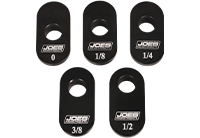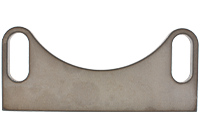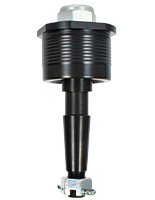Dialing in your Front Roll Center could be the magic difference that makes your car prevail in the center of the turn. But, is it really magic? I think that many times we over analyze Roll Center when really it is just another adjustment. We throw springs at the car and make shock changes. We adjust the bite and stagger on a whim. Changing the Front Roll Center at the track is crazy talk – or is it?
For perspective – we often move the Rear Roll Center in a care free trial and error fashion. If the car is loose it is common for teams to simply move the Rear Roll Center down by lowering the panhard bar or j bar an inch or two. Teams on TV or at your local Saturday night track move the Rear Roll Center just for fun and then move it back if the driver doesn’t like it. We move the Rear Roll Center up and down and really do it without over thinking.
When it comes to the Front Roll Center – it seems we have to consult witch doctors from Zimbabwe before we can think about making a change at the track. The misconception is that if a team were to change the Front Roll Center at the track then an ancient taboo would curse the team for the entire season.
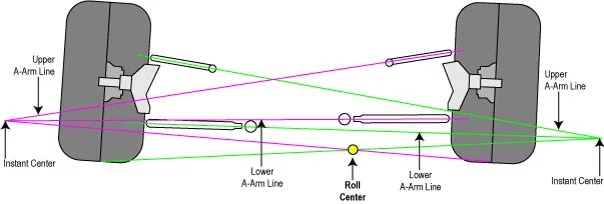 The Front Roll Center is a point in space that is derived from the LF and RF Instant Centers and their relationship to the contact patch.
The Front Roll Center is a point in space that is derived from the LF and RF Instant Centers and their relationship to the contact patch.
Really, Front Roll Center adjustments at the track are easy if performed with a little thought and reasonability. There is no mystery and while we are happy to move the Rear Roll Center all over the place we seem to be afraid of Front Roll Center adjustments at the track. In actuality, you could consider lowering the Front Roll Center at the track to rid the car of a nasty push just the same as you would raise the Panhard Bar or J-Bar to cure the condition? Really – you can. Just do it. If the driver likes the change then your team has found some new speed – if not then undo the adjustment with the same amount of thought as you put into moving the j-bar/panhard bar.
To help us become okay with making Front Roll Center trackside changes it pays to have a basic understanding of Roll Center both front and rear. Rear Roll Center is easy to understand as there is a physical part such as a j-bar or panhard bar for us to see. The Rear Roll Center is easy to calculate. Rear Roll Center is the average of the inner and outer mounting point heights at the center of the left and right mounting locations. Rear Roll Center may be easy to understand but in the end we just move it to adjust the car and then move it back if the driver complains. So simple.
The Front Roll Center can be confusing because on paper there are a bunch of lines going every which way. When the car goes through dynamic roll the lines go crazy as the pivot points move quickly which can give racers a headache – static front roll center is hard enough to comprehend but the data gets insane when you roll the chassis. But – what if we simplify the way we think about Front Roll Center? What if we view Front Roll Center like we view Rear Roll Center?
To simplify the Front Roll Center thought process it helps to understand the creation of the so called magical point. Front Roll Center is a calculated point versus a physical place. To find it you must first locate the Instant Center both left and right.
The RF Instant Center is found by drawing a line through the center of the RF upper A-Arm ball joint extended out through the center of the A-Arm inner pivot point on the frame. Another line is drawn from the RF outer ball joint center though the lower control arm frame pivot. The lower control arm line is extended out until it meets the upper control arm line. Where these lines intersect is called the Instant Center. The LF Instant Center is found in the same way.
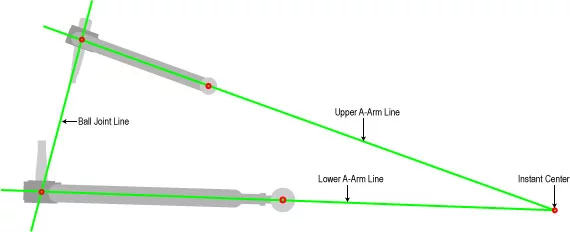 Instant Centers are much easier to visualize than Roll Centers. The Instant Center is simply the point where the upper control arm pivot point and the lower control arm pivot point lines intersect.
Instant Centers are much easier to visualize than Roll Centers. The Instant Center is simply the point where the upper control arm pivot point and the lower control arm pivot point lines intersect.
After the Instant Centers are located you can now find the Roll Center. From the RF Instant Center you draw a line back to the RF contact patch center. From the LF Instant Center you draw a line back to the LF contact patch center. Where these two imaginary lines cross is the Roll Center.
Car designers spend a ton of time figuring out mounting points and control arm lengths to come up with their idea of the optimal Roll Center. That said – Roll Center is just a point in space and there is little preventing you from moving the Roll Center around to find more speed. Sure, you shouldn’t go crazy but you can make reasonable and common sense adjustments quickly at the track.
For example – let’s say your car has a push and you tried raising the Rear Roll Center to free the car up. The driver didn’t like the change and now you want to try something else. You could adjust the bite, add stagger, soften the RF spring etc. OR – you could lower the Front Roll Center. You could just change the Front Roll Center by thinking out the variables just like you do at the rear. At the track, you could simply raise the RF A-arm inner pivot point. Raising the RF inner pivot would move the RF Instant Center down resulting in the Roll Center moving down and over to the left. The result is similar to having a softer RF spring through the timing of chassis roll.
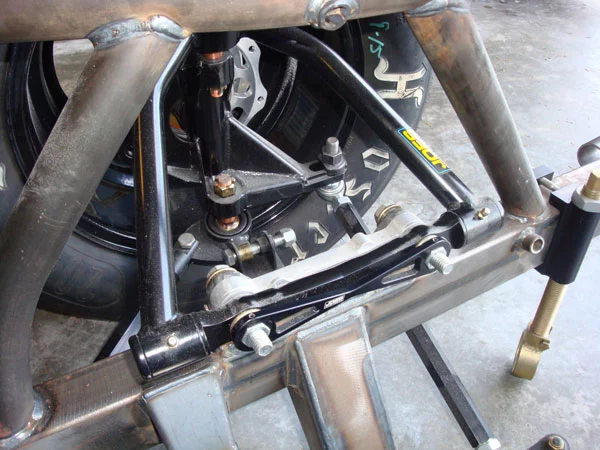 Increasing the angle at the RF upper A-Arm raises the Front Roll Center and moves it to the right.
Increasing the angle at the RF upper A-Arm raises the Front Roll Center and moves it to the right.
In order for the Front Roll Center track adjustment to be practical, it pays to worry less about the detail of the specific Roll Center location and focus on the Instant Center and your goal for the chassis adjustment. If you use a RF A-Arm frame mounting plate that is slotted for height adjustment you can use slugs to ensure you have repeatable and documentable changes. The idea is that when you move the rear roll center down a half inch you have something solid and repeatable to record in your set up book. For the Front Roll Center adjustment you can simply record that you moved the RF inner A-arm mounting point up a half inch with a slug. By understanding Roll Center and all the magic lines you can use your understanding to simplify the process at the track allowing for easy and practical changes. Changing a slug is pretty easy for a trial run and it is easy to repeat. If the driver doesn’t like the adjustment you can simply bolt the original slug back in and look for the next piece of hardware to move in your quest for more speed.
When would you try raising the RF A-arm pivot which results in a lower Roll Center? All adjustments are about timing. When and how does the car roll and what effect can we have on the timing of the chassis roll to make things occur at the right point in the corner? The ultimate goal of knowing the specific time in the corner to have the suspension move is the ultimate set up secret. If we truly knew how and when things move in the corner we would always have the fastest car! Since we don’t truly know – we gather all the information we can find from drivers, pyrometers, data acquisition or whatever and apply our experience to cut down the trial and error process. Even the guys on TV, that have unlimited access to money and engineering, are still in the position of using trial and error.
You can think about a trackside Roll Center adjustment if you wanted the car to experience stiffer front springs under braking yet have the front springs feel softer in the center of the turn. In the end – your decision making is just like the rear roll center process. When do you decide to move the rear j-bar up or down versus making a spring change? A Front Roll Center adjustment thought process is basically the same thing. Just move it!
We can easily move the upper pivot point of the front A-arms to reach a desired goal. Again, trial and error is part of the equation but the mystery of the Front Roll Center shouldn’t stop us. Moving the A-Arm pivots at the track is easy if you have the right hardware. Slotted A-plates and slugs work great.
A-Plate Slugs
Using and A-Plate slug to adjust your A-Arm inner pivot points gives you an easy and repeatable way to adjust your Front Roll Center right at the track.
You can move the lower points too, but you bring in rack location issues and bump steer corrections. If you take the time in your shop and know which rack spacers and lower pivot slugs to use at the track you could bolt in the new slugs quickly giving you more options. Your options need to consider camber change curves, static settings and bump steer effects. Changing the lower angles relieve you of camber curve considerations but are more time consuming so a focus on the upper A-Arms may be the best trackside compromise?
A-Arm Plate
A slotted A-Arm plate allows you to use slugs to make Front Roll Center Adjustments at the track giving you another weapon in your adjustment arsenal.
Lowering the RF A-Arm inner pivot raises the Front Roll Center and moves it to the right. Negative Camber is added and may need to be reset.
Raising the RF A-Arm inner pivot lowers the Front Roll Center and moves it to the left. Negative camber is reduced and may need to be reset.
Lowering the LF A-Arm inner pivot raises the Front Roll Center and moves it to the left. Positive camber is reduced and may need to be reset.
Raising the LF A-Arm inner pivot lowers the Front Roll Center and moves it to the right. Positive camber is added and may need to be reset.
Adjustable Ball Joints
An adjustable ball joint uses shims to change the A-Arm angle for quick Front Roll Center adjustments right at the track. A-Arm height an angle adjustments can be made just at the ball joint or in conjunction with inner pivot slug adjustments.
To further illustrate the point, I think that Front Roll Center is a design parameter that involves plenty of engineering and thought. I also think that if you have a basic understanding of Roll Center geometry that you can short cut the thought process at the track and simply focus on the LF and RF Instant Centers. At the track – you can easily visualize the effect on the RF instant center if you raise the RF a-arm inner pivot ½”. At this point in time you car is already “engineered” and you can just make the adjustment. By focusing on the Instant Centers you can readily make repeatable adjustments without having to worry about a bunch of imaginary lines. You can understand Instant Centers and their location quickly and easily. The reality is that Front Roll Center is simply a derivative of the Instant Center locations. Instant Centers are simple even through dynamic roll. Why complicate your trackside thought process with imaginary lines? Save the heavy thinking for the engineering room. At the track – just give it a try!
By understanding the Front Roll Center parameters and the imaginary points you can simplify the process and easily document which slug you are using to adjust your a-arms up and down. Focusing on Instant Centers makes it possible at the track. With this simplified thought process you can add another weapon to your adjustment arsenal and make adjustments that gets you ahead of your competition.

